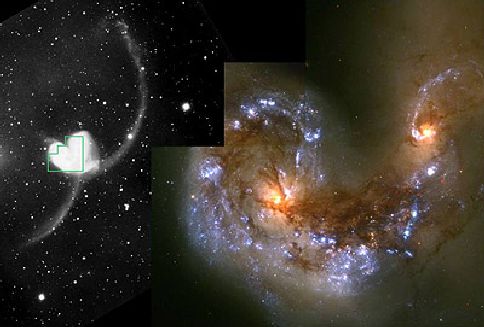The Antennae Galaxies

Credit & Copyright:
B. Whitmore (STScI),
F. Schweizer (DTM),
NASA
Explanation:
A ground-based telescopic view (left) of the collision between the galaxies
NGC4038 and
NGC4039
reveals long arcing insect-like "antennae" of luminous matter flung from
the scene of the accident.
Investigators using the Hubble Space Telescope to sift through the
cosmic wreckage near the two galaxy cores
have recently announced the discovery of over a thousand
bright young clusters of stars - the result of a burst of star formation
triggered by the collision.
The green outline shows the area covered by the higher resolution
Hubble image (right).
At the distance of the Antennae galaxies
(
about 63 million light-years),
a pixel in this image corresponds to about 15 light-years.
Dust clouds around the two galactic nuclei give them a
dimmed and reddened appearance while the
massive, hot, young stars of the newly formed clusters are blue.
How do colliding galaxies evolve with time?
Determining the ages of star clusters formed in galaxy collisions
can provide significant clues.
The Antennae galaxies are seen in
the southerly constellation Corvus.
Tomorrow's picture: Echoes Of A Supernova
Authors & editors:
Robert Nemiroff
(MTU) &
Jerry Bonnell
(USRA)
NASA Web Site Statements, Warnings,
and Disclaimers
NASA Official: Jay Norris.
Specific
rights apply.
A service of:
LHEA at
NASA /
GSFC
& Michigan Tech. U.

